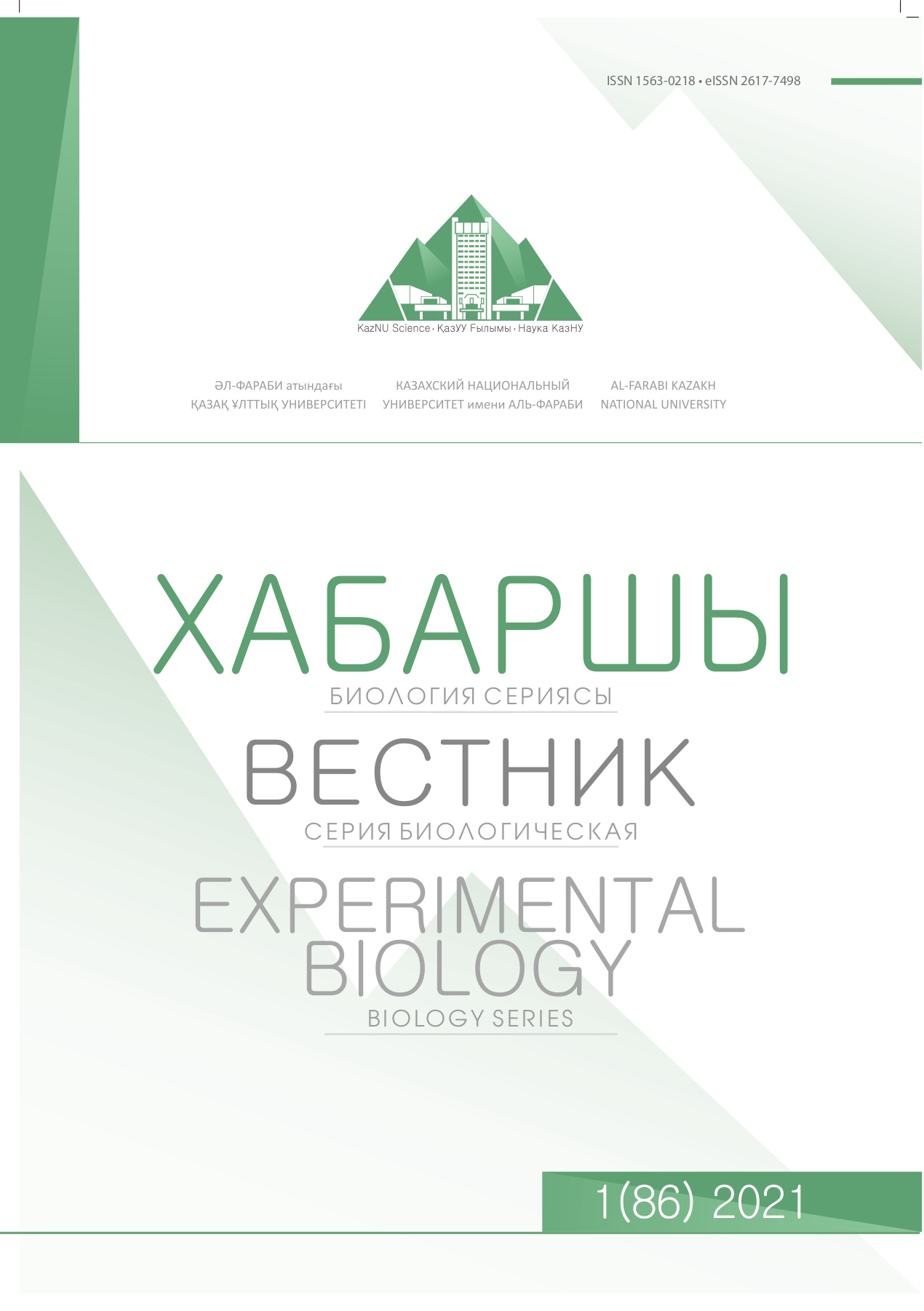СРАВНИТЕЛЬНЫЙ АНАЛИЗ ВЛИЯНИЯ МЕТОДОВ ПОДГОТОВКИ АНТИГЕНОВ ОПУХОЛИ НА ПРАЙМИРОВАНИЕ ДЕНДРИТНЫХ КЛЕТОК ЧЕЛОВЕКА И ЭФФЕКТИВНОЕ АКТИВИРОВАНИЕ ЦИТОКИН-ИНДУЦИРОВАННЫХ КЛЕТОК IN VITRO
DOI:
https://doi.org/10.26577/10.26577/eb.2021.v86.i1.08Аннотация
Адаптивная клеточная иммунотерапия, а именно комбинация дендритных клеток (ДК) и цитокин-индуцированных киллерных (ЦИК) клеток, является многообещающим подходом в лечении различных типов рака, и выбор подходящей методики получения опухолевых антигенов является сложной задачей. Клетки ЦИК также называемые НКТ клетками являются in vitro размноженной клеточной популяцией, для которой характерен смешанный НК клеточный и Т-клеточный фенотип. ДК это высоко специализированные антиген-презентирующие клетки, поглощающие, перерабатывающие и предоставляющие антигены эффекторным клеткам иммунной системы. В этом исследовании мы сравнили влияние опухолевых антигенов, полученных разными методами, на созревание дендритных клеток и их способность активировать ЦИК клетки. Цитотоксичность клеток ЦИК, полученных двумя различными способами (цельная кровь или мононуклеарные клетки периферической крови- МКПК), оценивали с использованием клеток SW620 в качестве мишени анализом МТТ. Согласно полученным результатам, ЦИК клетки, размноженные из цельной крови, показали значительно сильную противоопухолевую активность по сравнению с клетками ЦИК из МКПК, выделенных центрифугированием в градиенте плотности Histopaque-1077. Также мы определили, что могут быть использованы все проверенные методики получения антигена, с условием, что антиген-нагруженные ДК будут культивироваться совместно с ЦИК клетками, полученными из цельной крови.
Ключевые слова: цитокин-индуцированная киллерная клетка, дендритная клетка, иммуногенная гибель клеток, молекулярный фрагмент ассоциированный с повреждением, ФНО-альфа.
Библиографические ссылки
2. Ruella M, Kalos M (2014) Adoptive immunotherapy for cancer. Immunol Rev 257:14–38. https://doi.org/10.1111/imr.12136
3. Steinman RM, Cohn ZA (1973) Identification of a novel cell type in peripheral lymphoid organs of mice. I. Morphology, quantitation, tissue distribution. J Exp Med 137:1142–1162. https://doi.org/10.1084/jem.137.5.1142
4. Inaba K, Metlay JP, Crowley MT, et al (1990) Dendritic cells as antigen presenting cells in vivo. Int Rev Immunol 6:197–206. https://doi.org/10.3109/08830189009056630
5. de Winde CM, Munday C, Acton SE (2020) Molecular mechanisms of dendritic cell migration in immunity and cancer. Med Microbiol Immunol (Berl) 209:515–529. https://doi.org/10.1007/s00430-020-00680-4
6. Schmidt-Wolf IG, Negrin RS, Kiem HP, et al (1991) Use of a SCID mouse/human lymphoma model to evaluate cytokine-induced killer cells with potent antitumor cell activity. J Exp Med 174:139–149. https://doi.org/10.1084/jem.174.1.139
7. Sangiolo D (2011) Cytokine Induced Killer Cells as Promising Immunotherapy for Solid Tumors. J Cancer 2:363–368
8. Iudicone P, Fioravanti D, Cicchetti E, et al (2016) Interleukin-15 enhances cytokine induced killer (CIK) cytotoxic potential against epithelial cancer cell lines via an innate pathway. Hum Immunol 77:1239–1247. https://doi.org/10.1016/j.humimm.2016.09.003
9. Bremm M, Pfeffermann L-M, Cappel C, et al (2019) Improving Clinical Manufacturing of IL-15 Activated Cytokine-Induced Killer (CIK) Cells. Front Immunol 10:. https://doi.org/10.3389/fimmu.2019.01218
10. Heinze A, Grebe B, Bremm M, et al (2019) The Synergistic Use of IL-15 and IL-21 for the Generation of NK Cells From CD3/CD19-Depleted Grafts Improves Their ex vivo Expansion and Cytotoxic Potential Against Neuroblastoma: Perspective for Optimized Immunotherapy Post Haploidentical Stem Cell Transplantation. Front Immunol 10:. https://doi.org/10.3389/fimmu.2019.02816
11. Pan Q-Z, Liu Q, Zhou Y-Q, et al (2020) CIK cell cytotoxicity is a predictive biomarker for CIK cell immunotherapy in postoperative patients with hepatocellular carcinoma. Cancer Immunol Immunother 69:825–834. https://doi.org/10.1007/s00262-020-02486-y
12. Yang L, Ren B, Li H, et al (2013) Enhanced antitumor effects of DC-activated CIKs to chemotherapy treatment in a single cohort of advanced non-small-cell lung cancer patients. Cancer Immunol Immunother 62:65–73. https://doi.org/10.1007/s00262-012-1311-8
13. Qu H-Q, Zhou X-S, Zhou X-L, Wang J (2014) Effect of DC-CIK cell on the proliferation, apoptosis and differentiation of leukemia cells. Asian Pac J Trop Med 7:659–662. https://doi.org/10.1016/S1995-7645(14)60111-5
14. Obeid M, Tesniere A, Ghiringhelli F, et al (2007) Calreticulin exposure dictates the immunogenicity of cancer cell death. Nat Med 13:54–61. https://doi.org/10.1038/nm1523
15. Radogna F, Diederich M (2018) Stress-induced cellular responses in immunogenic cell death: Implications for cancer immunotherapy. Biochem Pharmacol 153:12–23. https://doi.org/10.1016/j.bcp.2018.02.006
16. Strome SE, Voss S, Wilcox R, et al (2002) Strategies for Antigen Loading of Dendritic Cells to Enhance the Antitumor Immune Response. Cancer Res 62:1884–1889
17. Kornacker M, Moldenhauer G, Herbst M, et al (2006) Cytokine-induced killer cells against autologous CLL: Direct cytotoxic effects and induction of immune accessory molecules by interferon-γ. Int J Cancer 119:1377–1382. https://doi.org/10.1002/ijc.21994
18. Liu Y, Liu H, Liu H, et al (2016) Dendritic cell-activated cytokine-induced killer cell-mediated immunotherapy is safe and effective for cancer patients >65 years old. Oncol Lett 12:5205–5210. https://doi.org/10.3892/ol.2016.5337
19. Nishimura R, Baker J, Beilhack A, et al (2008) In vivo trafficking and survival of cytokine-induced killer cells resulting in minimal GVHD with retention of antitumor activity. Blood 112:2563–2574. https://doi.org/10.1182/blood-2007-06-092817
20. Rettinger E, KuçI S, Naumann I, et al (2012) The cytotoxic potential of interleukin-15-stimulated cytokine-induced killer cells against leukemia cells. Cytotherapy 14:91–103. https://doi.org/10.3109/14653249.2011.613931
21. Jafari S, Lavasanifar A, Hejazi MS, et al (2020) STAT3 inhibitory stattic enhances immunogenic cell death induced by chemotherapy in cancer cells. DARU J Pharm Sci 28:159–169. https://doi.org/10.1007/s40199-020-00326-z
22. Gu J, Li Z, Zhou J, et al (2019) Response prediction to oxaliplatin plus 5‑fluorouracil chemotherapy in patients with colorectal cancer using a four‑protein immunohistochemical model. Oncol Lett 18:2091–2101. https://doi.org/10.3892/ol.2019.10474
23. Inoue H, Tani K (2014) Multimodal immunogenic cancer cell death as a consequence of anticancer cytotoxic treatments. Cell Death Differ 21:39–49. https://doi.org/10.1038/cdd.2013.84
24. Liu P, Zhao L, Loos F, et al (2017) Identification of pharmacological agents that induce HMGB1 release. Sci Rep 7:14915. https://doi.org/10.1038/s41598-017-14848-1
25. Dubyak GR (2019) Luciferase-assisted detection of extracellular ATP and ATP metabolites during immunogenic death of cancer cells. Methods Enzymol 629:81–102. https://doi.org/10.1016/bs.mie.2019.10.006
26. Yoon S, Park SJ, Han JH, et al (2014) Caspase-dependent cell death-associated release of nucleosome and damage-associated molecular patterns. Cell Death Dis 5:e1494–e1494. https://doi.org/10.1038/cddis.2014.450
27. Li C, Sun H, Wei W, et al (2020) Mitoxantrone triggers immunogenic prostate cancer cell death via p53-dependent PERK expression. Cell Oncol. https://doi.org/10.1007/s13402-020-00544-2
28. Bezu L, Sauvat A, Humeau J, et al (2018) eIF2α phosphorylation is pathognomonic for immunogenic cell death. Cell Death Differ 25:1375–1393. https://doi.org/10.1038/s41418-017-0044-9
29. López MN, Pereda C, Segal G, et al (2009) Prolonged Survival of Dendritic Cell–Vaccinated Melanoma Patients Correlates With Tumor-Specific Delayed Type IV Hypersensitivity Response and Reduction of Tumor Growth Factor β-Expressing T Cells. J Clin Oncol 27:945–952. https://doi.org/10.1200/JCO.2008.18.0794
30. Rojas-Sepúlveda D, Tittarelli A, Gleisner MA, et al (2018) Tumor lysate-based vaccines: on the road to immunotherapy for gallbladder cancer. Cancer Immunol Immunother 67:1897–1910. https://doi.org/10.1007/s00262-018-2157-5




